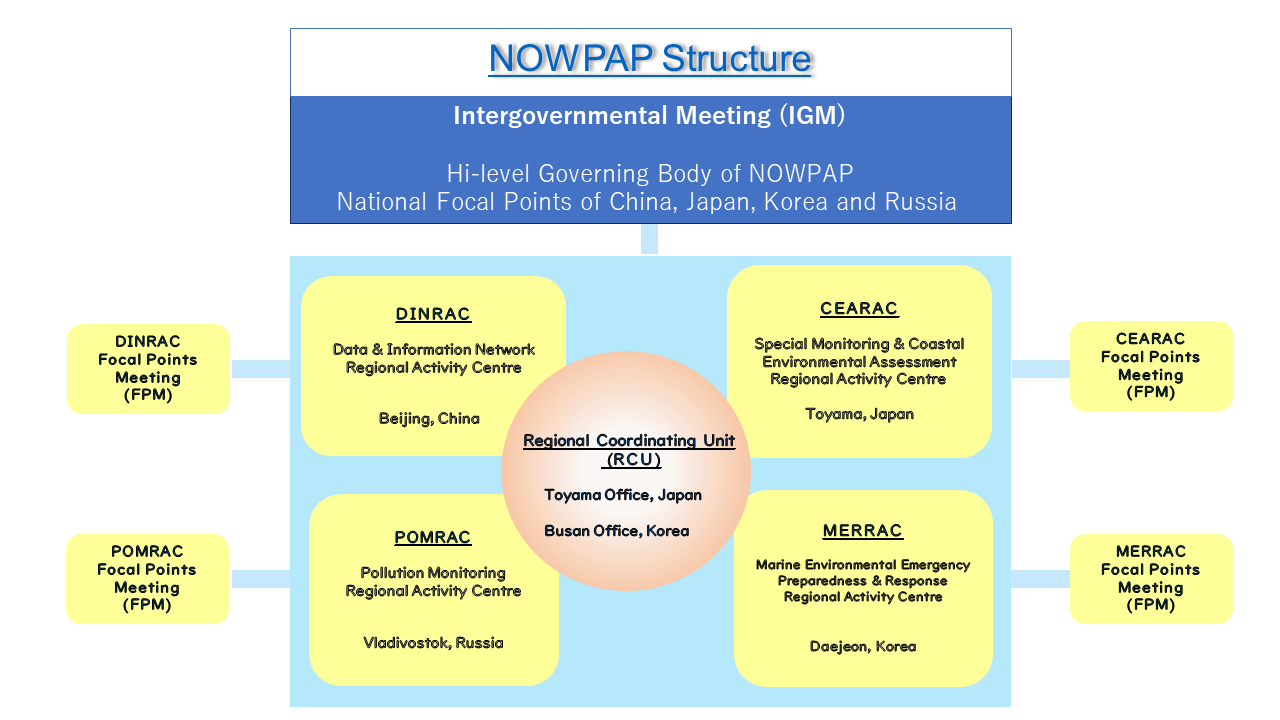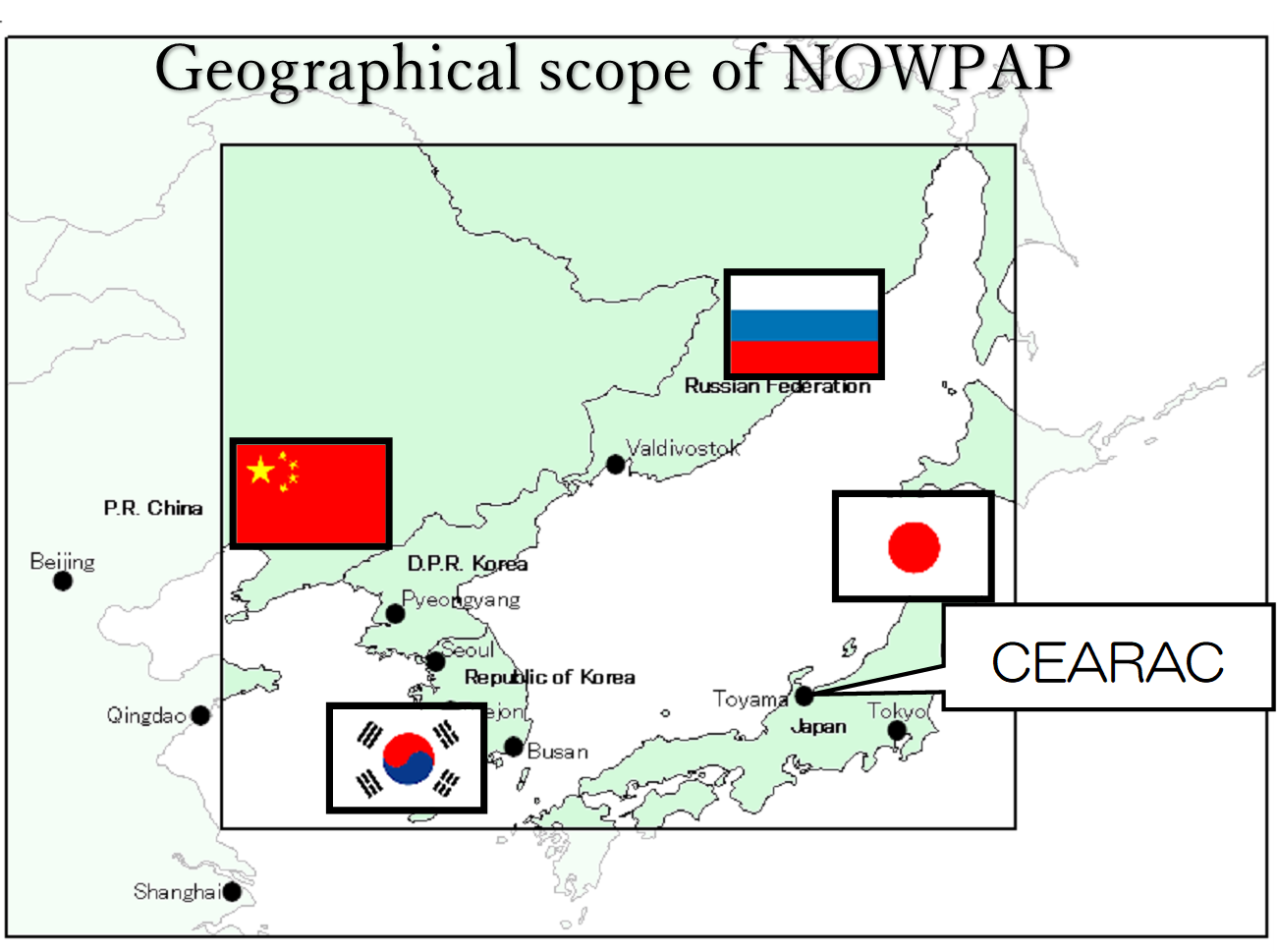What is NOWPAP?
The Action Plan for the Protection, Management and Development of the Marine and Coastal Environment of the Northwest Pacific Region (NOWPAP) is one of the Regional Seas Programmes (RSP) of the United Nations Environment Programme (UNEP).
The geographical coverage of NOWPAP is the marine environment and coastal zones from about 121o E to 143o E longitude, and from approximately 33o N to 52o N latitude.
NOWPAP was adopted at the First Intergovernmental Meeting (IGM) in September 1994 in Seoul, Korea. The member states of NOWPAP are the People’s Republic of China, Japan, the Republic of Korea and Russian Federation.
For smooth implementation of NOWPAP activities, Regional Activity Centres (RACs) were established in each member state between 2000 and 2002.
While NOWPAP activities are implemented on a biennium basis, the IGM is held every year. The meeting, consisting of representatives of the relevant ministries such as the ministry of the environment of each member state, reviews the progress of on-going activities as well as outcomes of the finished activities of the term. The meeting also discusses and adopts the workplan for the next biennium.
Focal Points Meeting (FPM), the advisory body of each RAC, is basically held annually to exchange information and coordinate and harmonize regional cooperation in order to advance activities of NOWPAP and each RAC.
In November 2004, the Regional Coordinating Unit (RCU) of NOWPAP was established with two offices: one in Toyama City, Japan and the other is in Busan City, Korea.

What is CEARAC?
In 1999, the Northwest Pacific Region Environmental Cooperation Center (NPEC) in Toyama, Japan was designated as the Special Monitoring & Coastal Environmental Assessment Regional Activity Centre (CEARAC), a RAC of Japan.
In July 2002, the Memorandum of Understanding (MoU) was concluded between UNEP and NPEC, in which “assessment of the marine and coastal environment of the NOWPAP region” and “development of monitoring and assessment tools by using new monitoring techniques such as remote sensing” were set forth in it as priority working areas of CEARAC. Then, the seventh IGM (March 2002, Vladivostok, Russia) decided the prioritized activities of CEARAC, and two working groups (WG) of NOWPAP were established under CEARAC as follows:
Up to 2006, WG3 and WG4 meetings were held separately; however, in the occasion of launching new CEARAC activities on eutrophication, more cooperation and collaboration between the two WGS were expected. Thus, a joint meeting of WG3 and WG4 was held in 2008, and since then, CEARAC has organized expert meetings for each working areas with relevant researchers from the four member states, and other NOWPAP RACs and NOWPAP partner organizations.
At present, CEARAC implements several activities including HABs, RS and eutrophication to contribute to conservation of the NOWPAP sea area. This website introduces the current six priority working areas of CEARAC.
Since 2003, the NOWPAP CEARAC Focal Points Meeting (FPM) has been held once a year in general. Focal Points (FPs) are the people who are either scientists of the marine environment or government officials of the four NOWPAP member states.
| Current list of FPs As of March 2024 |
||
|---|---|---|
| Country | Name | Organization |
| China | Dr. Liu XIHUI | China National Environmental Monitoring Center |
| Dr. Jianchao FAN | National Marine Environmental Monitoring Center | |
| Japan | Ms. Noriko TAMIYA-HASE | Ministry of Environment Japan |
| Dr. Joji ISHIZAKA | Nagoya University | |
| Dr. Nobuyuki YAGI | The University of Tokyo | |
| Korea | Dr. Bong-Oh KWON | Kunsan National University |
| Dr. Jinsoon PARK | Korea Marine and Ocean University | |
| Dr. Hye Seon KIM | National Marine Biodiversity Institute of Korea | |
| Russia | Dr. Vladimir SHULKIN | Far Eastern Branch of the Russian Academy of Sciences |
| Dr. Tatiana ORLOVA | Far Eastern Branch of the Russian Academy of Sciences | |


